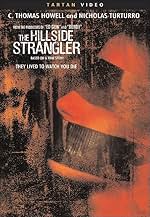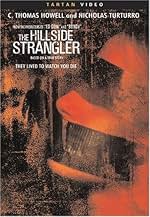CALIFICACIÓN DE IMDb
5.2/10
2 k
TU CALIFICACIÓN
Agrega una trama en tu idiomaKenneth is obsessed with the police, he moves to LA with his cousin, Angelo convinces him to start a prostitution business. Frustrated decide on revenge, feeling a great pleasure with her de... Leer todoKenneth is obsessed with the police, he moves to LA with his cousin, Angelo convinces him to start a prostitution business. Frustrated decide on revenge, feeling a great pleasure with her death. The two cousins become addicted to death.Kenneth is obsessed with the police, he moves to LA with his cousin, Angelo convinces him to start a prostitution business. Frustrated decide on revenge, feeling a great pleasure with her death. The two cousins become addicted to death.
- Premios
- 1 nominación en total
Jennifer Tisdale
- Erin
- (as Jennifer Kelly Tisdale)
Samantha Tabak
- Heather Brewer
- (as Tricia Dickson)
Kylie Rachel
- Peaches
- (as Kylie Rachelle)
- Dirección
- Guionistas
- Todo el elenco y el equipo
- Producción, taquilla y más en IMDbPro
Argumento
¿Sabías que…?
- TriviaNicholas Turturro was recommended to director Chuck Parello by a friend.
- ConexionesReferences Garganta profunda (1972)
Opinión destacada
Is there anything more inscrutable and unfathomable than the mind of a serial killer? Probably not, yet, year after year, undeterred filmmakers attempt to come to grips with this elusive subject matter, usually with unsatisfactory results.
Generally, serial killer stories are placed in the context of a police procedural, in which a crack homicide investigator searches for clues in the hopes of finding the culprit before he can claim his next victim. But, once in awhile, filmmakers will take a more serious approach to the topic, focusing more on the killer himself, his methods and his madness, as a means of trying to "open up" the psyche of such a person in the hopes of finding answers. "The Hillside Strangler" is in the second category.
The so-called "Hillside Strangler" actually turned out to be TWO serial killers who, working in tandem, terrorized Los Angeles in the early 1970's. Kenneth Bianchi and Angelo Buono were "cousins" who acted out their hatred of women by kidnapping, raping and slaughtering an assortment of innocent victims they picked out at random (they started with streetwalkers, then branched out to women in general). Bianchi was a loser "nobody" who found murdering helpless young women and terrorizing a whole city (albeit in anonymity) the only way in which he could achieve the status of a "somebody." Buono was a smalltime auto repairman who, through the murders, finally got the opportunity to act out his sadistic sexual fantasies on an epic scale. In fact, as portrayed in the movie, both men use the killings as the ultimate orgasm, confusing the destruction of the helpless with sexual fulfillment.
The problem with a movie like "The Hillside Strangler" is that, no matter how serious it is in its intention and approach, the film is bound to feel exploitative in its darkest moments. Although this is definitely no sensationalistic rabblerousing gore-fest like "The Texas Chainsaw Massacre," after we've watched a half dozen or so innocent terrified young girls being essentially tortured to death, we still wind up asking ourselves what the purpose of the movie really is. Director Chuck Parello adopts a cool, detached, documentary-style tone throughout, but it still isn't enough to smooth us past the emotionally disturbing rough patches.
That being said, there are a few quality elements in "The Hillside Strangler" provided one has a high tolerance for depictions of disturbing violence. The movie effectively shows just how easily two utterly amoral individuals can pass for rational and normal in the eyes of the outside world. Bianchi is particularly adept at leading a double life, going so far as pulling the wool over the eyes of his very own wife who has no clue about her husband's deadly nocturnal activities. C. Thomas Howell and Nicholas Turturro give complex, chilling performances as Bianchi and Buono, keeping us on the knife-edge of suspense through much of the movie. The film also does a good job capturing the look of the '70's, right on down to the polyester clothes, perms and ubiquitous moustaches that helped to define the era. The poorly lit, slightly grainy photography also gives the film the look of one of those low budget exploitation pictures of thirty years ago. (There is at least one inadvertent anachronism in the film: the skyline we see in some of the establishing shots is of Los Angeles today, not three decades ago).
The screenplay by Parello and Stephen Johnston pays little heed to the detection aspects of the story, so much so that we never find out what it is that made the police suspicious of Bianchi in the first place. We see him being apprehended but have no idea what the clues were that led to his capture. This is a frustration oversight on the part of the filmmakers.
"The Hillside Strangler" deserves credit for at least trying to bring a more controlled, less sensationalistic approach to a topic that often gets thrown onto the trash heap of two-bit police dramas and slasher horror films. But, for all its good intentions, the film doesn't wind up revealing much about the psychotic mindset that we didn't already know before. Thus, the rewards are not sufficient compensation for the unpleasantness of sitting through so much of the movie.
Generally, serial killer stories are placed in the context of a police procedural, in which a crack homicide investigator searches for clues in the hopes of finding the culprit before he can claim his next victim. But, once in awhile, filmmakers will take a more serious approach to the topic, focusing more on the killer himself, his methods and his madness, as a means of trying to "open up" the psyche of such a person in the hopes of finding answers. "The Hillside Strangler" is in the second category.
The so-called "Hillside Strangler" actually turned out to be TWO serial killers who, working in tandem, terrorized Los Angeles in the early 1970's. Kenneth Bianchi and Angelo Buono were "cousins" who acted out their hatred of women by kidnapping, raping and slaughtering an assortment of innocent victims they picked out at random (they started with streetwalkers, then branched out to women in general). Bianchi was a loser "nobody" who found murdering helpless young women and terrorizing a whole city (albeit in anonymity) the only way in which he could achieve the status of a "somebody." Buono was a smalltime auto repairman who, through the murders, finally got the opportunity to act out his sadistic sexual fantasies on an epic scale. In fact, as portrayed in the movie, both men use the killings as the ultimate orgasm, confusing the destruction of the helpless with sexual fulfillment.
The problem with a movie like "The Hillside Strangler" is that, no matter how serious it is in its intention and approach, the film is bound to feel exploitative in its darkest moments. Although this is definitely no sensationalistic rabblerousing gore-fest like "The Texas Chainsaw Massacre," after we've watched a half dozen or so innocent terrified young girls being essentially tortured to death, we still wind up asking ourselves what the purpose of the movie really is. Director Chuck Parello adopts a cool, detached, documentary-style tone throughout, but it still isn't enough to smooth us past the emotionally disturbing rough patches.
That being said, there are a few quality elements in "The Hillside Strangler" provided one has a high tolerance for depictions of disturbing violence. The movie effectively shows just how easily two utterly amoral individuals can pass for rational and normal in the eyes of the outside world. Bianchi is particularly adept at leading a double life, going so far as pulling the wool over the eyes of his very own wife who has no clue about her husband's deadly nocturnal activities. C. Thomas Howell and Nicholas Turturro give complex, chilling performances as Bianchi and Buono, keeping us on the knife-edge of suspense through much of the movie. The film also does a good job capturing the look of the '70's, right on down to the polyester clothes, perms and ubiquitous moustaches that helped to define the era. The poorly lit, slightly grainy photography also gives the film the look of one of those low budget exploitation pictures of thirty years ago. (There is at least one inadvertent anachronism in the film: the skyline we see in some of the establishing shots is of Los Angeles today, not three decades ago).
The screenplay by Parello and Stephen Johnston pays little heed to the detection aspects of the story, so much so that we never find out what it is that made the police suspicious of Bianchi in the first place. We see him being apprehended but have no idea what the clues were that led to his capture. This is a frustration oversight on the part of the filmmakers.
"The Hillside Strangler" deserves credit for at least trying to bring a more controlled, less sensationalistic approach to a topic that often gets thrown onto the trash heap of two-bit police dramas and slasher horror films. But, for all its good intentions, the film doesn't wind up revealing much about the psychotic mindset that we didn't already know before. Thus, the rewards are not sufficient compensation for the unpleasantness of sitting through so much of the movie.
- Buddy-51
- 7 ago 2005
- Enlace permanente
Selecciones populares
Inicia sesión para calificar y agrega a la lista de videos para obtener recomendaciones personalizadas
Detalles
- Fecha de lanzamiento
- País de origen
- Sitio oficial
- Idioma
- También se conoce como
- The Hillside Strangler
- Locaciones de filmación
- Hollywood, Los Ángeles, California, Estados Unidos(main location)
- Productoras
- Ver más créditos de la compañía en IMDbPro
Taquilla
- Presupuesto
- USD 1,400,000 (estimado)
- Total en EE. UU. y Canadá
- USD 4,143
- Fin de semana de estreno en EE. UU. y Canadá
- USD 306
- 26 sep 2004
- Total a nivel mundial
- USD 4,143
Contribuir a esta página
Sugiere una edición o agrega el contenido que falta

Principales brechas de datos
By what name was El estrangulador de Hillside (2004) officially released in Canada in English?
Responda
































